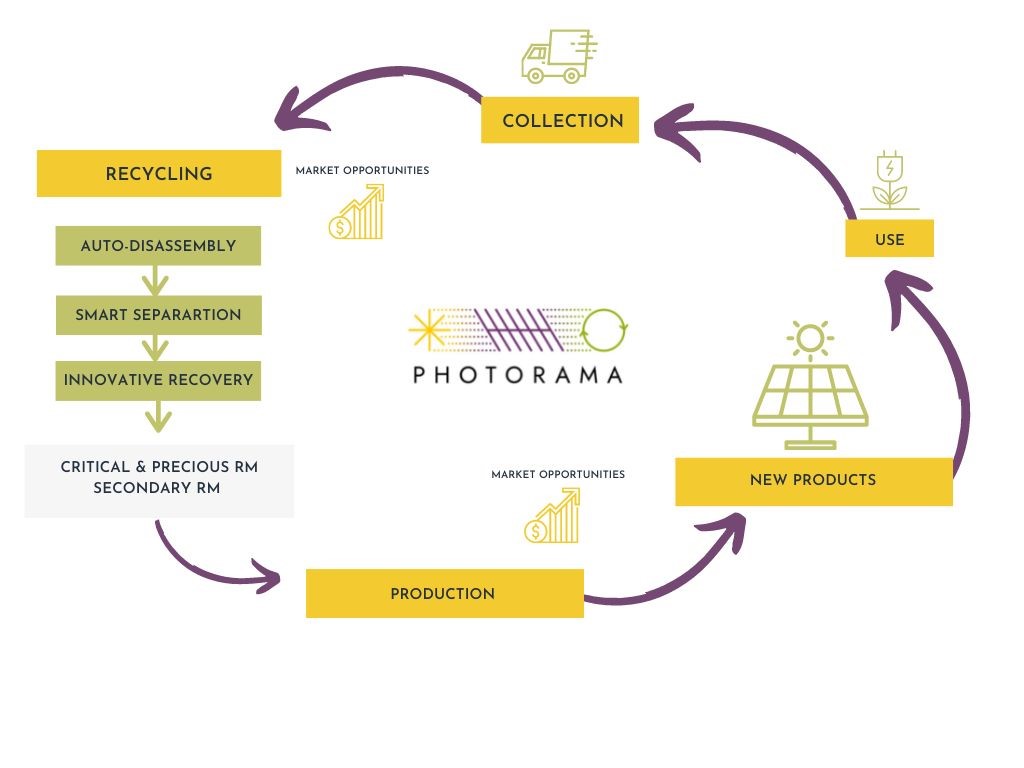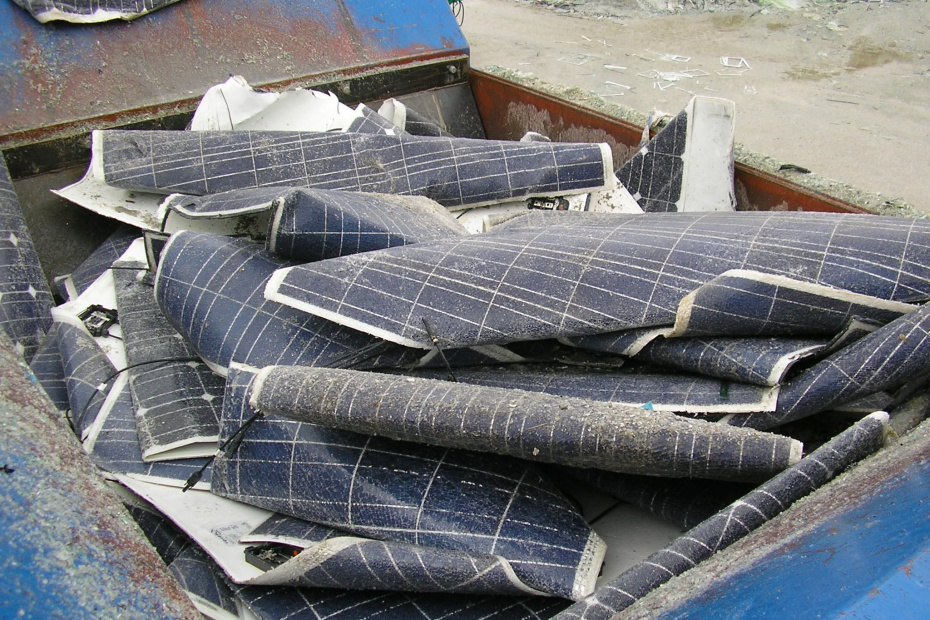Renewable solar energy is one of the most promising candidates to lead the energy transition. Indeed, solar energy, often generated through the use of Photovoltaic (PV) panels, brings along the promise of fossil-free clean energy. To enter this paradigm, the PV industry has to be thought globally in a comprehensive circular approach considering the whole value chain. Nowadays, the process of PV panels discarding is still far from reaching high environmental and ethical standards. In this short article, we introduce the key issues associated with recycling of PV panels and how the PHOTORAMA project will help coordinate solutions to meet the challenges of PV waste management.
What is the issue with PV panels current production and discarding system?
PV panels, while generating fossil-free energy, rely on an energy and material intensive manufacturing process. Looking at the huge challenge coming in the next decades, PV manufacturers are clearly aware of the opportunities. However, they also understood the crucial role of solar energy and the requirement of being exemplary in the fight against climate change. In that regard, the PV community has been proactive to implement a more sustainable approach from a very early stage. Many efforts have been already investigated to evaluate and lower the environmental impacts of the manufacturing stages. However, the end of life of PV devices and PV systems remains the weak point of the value chain, as there is evidently a lack of efficient recycling technologies. With a particularly long average lifetime of about 30 years, the waste generated has been predicted from a long-term standpoint. However, PV waste is coming and will grow faster than predicted looking at the massive deployment of solar energy. Already today, PV waste is becoming a major concern in areas such as Europe, US, Japan etc. that needs to be addressed.
The current status-quo of PV panels’ waste management is rather bleak: While the upcoming PV waste has been estimated with substantial cumulative volumes of ~10 Million tons in Europe and 60-78 Million tons worldwide expected by 2050[1], PV panels are still for the most part landfilled.
Even though strong efforts are ongoing at the legislative level (Europe WEEE directive, US Washington state, Japan, Korea, Australia and India), we urgently need to develop efficient recycling solutions. In Europe, some recycling facilities are currently operating PV waste management. Nevertheless, the technologies mostly based on shredding processes do not allow for efficient recovery and recycling and can be identified as “down-cycling” practices.
PV panels contain both useful conventional resources such as aluminium, copper, glass and critical/valuable materials (Si, Ag, In, Ga, etc.) as well as hazardous materials (lead, cadmium, selenium). The challenges to recycle such devices are to be able (1) to separate selectively the multi-layer sandwich made of the glass front sheet, solar cells and polymer backsheet sealed by a polymer encapsulant and (2) to recover the critical and valuable metals from the solar cells.
Two issues arise from the materials encapsulated in the multi-layers. First, the common practice of landfilling might imply unwanted environmental burdens such as the dispersion of toxic material. Second, the lack of proper recycling solutions can lead to the irreversible loss of critical and valuable materials.
The critical and valuable materials embodied in PV panels are limited resources in very high demand by several sectors. They are absolutely necessary for manufacturing the next generation of PV panels. Indeed, the demand is bound to increase with the growth of solar electricity generation which is expected to reach a cumulative solar PV capacity of 2840 GW by 2030 and 8519 GW by 2050. The situation is quite alarming considering that the projection for 2050 is equivalent to eighteen times the total PV capacity as compared to 2018[2]. The raw materials have to be available for such production!
Ore deposits, necessary for the extraction of critical RM, are found in several countries outside the EU. The market is generally dominated by China, which makes the EU dependent on exports to ensure its supply of RM[3]. Indeed, the European PV industry has suffered these last years from a very competitive Asian market. However, Europe is back on track to relaunch the industry locally and this initiative is strongly supported by the European Commission. In such context, the recovery of high-purity secondary raw materials is becoming one of the key assets to secure the supply of raw materials in Europe.
What is the role of PHOTORAMA?
PHOTOTRAMA stands for PHOtovoltaic waste management – advanced Technologies for recOvery & recycling of secondary RAw MAterials from end-of-life modules. As the title indicates, the project aims to improve the current waste management of PV panels through the development of innovative technologies, targeting high-efficiency PV recycling and high purity secondary raw material recovery.
Through a comprehensive and circular approach, PHOTORAMA will bridge sectors from collection to production of secondary RM and will reintroduce the outputs as new useable materials and products in industrial value chains.
For this purpose, PHOTORAMA is setting up a full management-Pilot Line. By developing innovative automated disassembly, layer separation, recovery and recycling technologies, the Pilot Line will enable the implementation of a relevant economic business case for high-recovery (>98%) of PV waste at high Technology Readiness Level (TRL) such as pilot prototype in an industrial environment. To close the loop, all fractions of PV End of Life (EoL) components will be either directly recovered as energy fuel, re-used or recycled as RM feedstock to build new PV panels or other new products.

By introducing new technologies capable of efficiently recovering materials PHOTORAMA will generate positive environmental and social impacts and prevent the adverse effects linked to PV panel production and subsequent landfilling.
Looking at the big picture, the expected impacts of the project are to:
1. Increase measurably the efficiency and effectiveness (range, yield, quality, and selectivity of recovered RM) of the exploitation of complex secondary RM
2. Unlock a significant volume of various secondary RM currently unexploited /underexploited within the EU, hence improving their circularity in the economy
3. Improve health, safety & environmental performance throughout the whole life cycle of PV panels
4. Improve economic viability & market potential, expanding EU business, creating added value and new jobs
5. Push the EU to the forefront in RM processing, recycling & solutions promoting socially innovative solutions
Learn more about PHOTORAMA’s consortium and workflow here.
[1] International Renewable Energy Agency IRENA- Report “End-of-Life management solar photovoltaic panels”, 2016. https://www.irena.org/-/media/Files/IRENA/Agency/Publication/2016/IRENA_IEAPVPS_End-of-Life_Solar_PV_Panels_2016.pdf
[2] International Renewable Energy Agency IRENA- Report “Future of Solar Photovoltaic”, 2019. https://irena.org/-/media/Files/IRENA/Agency/Publication/2019/Nov/IRENA_Future_of_Solar_PV_2019.pdf
[3] Grandell, Leena & Höök, Mikael. (2015). Assessing Rare Metal Availability Challenges for Solar Energy Technologies. Sustainability. 7. 11818-11837. 10.3390/su70911818b
